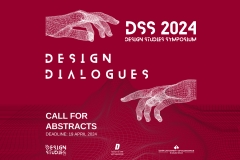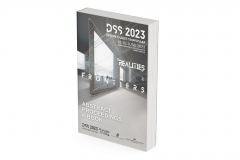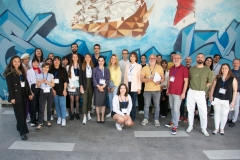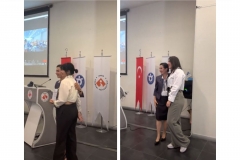
GRADUATE SCHOOL
Design Studies (With Thesis)
FFD 503 | Course Introduction and Application Information
| Course Name |
Design Representation Theories
|
|
Code
|
Semester
|
Theory
(hour/week) |
Application/Lab
(hour/week) |
Local Credits
|
ECTS
|
|
FFD 503
|
Fall/Spring
|
3
|
0
|
3
|
7.5
|
| Prerequisites |
None
|
|||||
| Course Language |
English
|
|||||
| Course Type |
Elective
|
|||||
| Course Level |
Second Cycle
|
|||||
| Mode of Delivery | - | |||||
| Teaching Methods and Techniques of the Course | - | |||||
| Course Coordinator | - | |||||
| Course Lecturer(s) | - | |||||
| Assistant(s) | - | |||||
| Course Objectives | To enable critical approaches to design by focusing on the intersections between design knowledge and contemporary cultural theories |
| Learning Outcomes |
The students who succeeded in this course;
|
| Course Description | This course explores the relationship between design, and contemporary cultural discourses including modernism, postmodernism, (post)structuralist theory, postcolonial positions. |
|
|
Core Courses | |
| Major Area Courses |
X
|
|
| Supportive Courses | ||
| Media and Management Skills Courses | ||
| Transferable Skill Courses |
WEEKLY SUBJECTS AND RELATED PREPARATION STUDIES
| Week | Subjects | Related Preparation |
| 1 | Introduction to the course themes | No preparation / Assignment I: dividing chapters for week 4, student presentation |
| 2 | Modernism in art | Robert Hughes, The shock of the new, London 1991, chapter 1, pp.9-56 |
| 3 | Design: The road to Modernism | Nikolaus Pevsner, Pioneers of Modern Design, 1936, p. 118-217 |
| 4 | Design: The Road to Modernism Student Presentations I | Nikolaus Pevsner, Pioneers of Modern Design, 1936, p. 19-117 |
| 5 | Modernist sources/ The Bauhaus | Jan Tschichold, The New Typography, Berkely/Los Angeles/London 1995 (German or. 1928), p. 7-86 |
| 6 | Modernist utopia | Robert Hughes, The shock of the new, London 1991, chapter 4, p. 164-211 |
| 7 | Midterm exam | About all previous literature |
| 8 | Modernism criticized | R. Venturi, D. Scott Brown, S. Izenour, Learning from Las Vegas, Cambridge Ma. 1972 |
| 9 | Modernism criticized | V. Scully, Architecture, sculpture and painting: environment, act and illusion, in: Modern Architecture and other essays, Princeton/Oxford 2003, p. 198-235 |
| 10 | Deconstructivism Essay assignment: Find a text pertaining to your field of research that is critical of modernism, and apply this criticism to a design product not mentioned in that text (ca. 1500 words) | B. English,’Sartorial deconstruction: The nature of conceptualism in postmodernist Japanese fashion design,’ The International Journal of the Humanities 9 (2011), pp. 81-85. |
| 11 | Postcolonialism/deconstructivism | N. Mirzoeff, An introduction to visual culture, London/New York 1999, p. 176-196 (‘Inventing the West’) |
| 12 | Individual appointments | |
| 13 | The persistence of modenism in design and design education | V. Margolin, Design History and Design Studies, in: The Politics of the Artificial, Chicago 2002, p. 218-233 |
| 14 | A real alternative? | Patrick Schumacher, Parametricism as style, London 2008 http://www.patrikschumacher.com/Texts/Parametricism%20as%20Style.htm |
| 15 | Student presentatins and feedback on critical essay | |
| 16 | Overview and Final Submission |
| Course Notes/Textbooks | A reader composed of selected texts (see above) will be prepared by the instructor. |
| Suggested Readings/Materials | Peter Barry, Beginning Theory (Manchester: Manchester University Press, 1995) Terry Eagleton, Literary Theory (Minneapolis: The University of Minnesota Press, 2003) Roland Barthes, “Myth Today” in Mythologies (New York: Hill and Wang, 1972), pp. 109159. Karen Burns, “Architecture: That Dangerous Useless Supplement” in the proceedings of Accessory/Architecture, New Zealand, Auckland University, 1995, pp. 4956. Kaja Silverman, “The Look,” in The Threshold of the Visible World (New York: Routledge, 1996), pp. 125163. Annette Kuhn, “The Body and Cinema” in Susan Sheridan ed., Grafts (London: Verso, 1988), pp. 1124. David M. Halperin, “The Normalization of Queer Theory,” Journal of Homosexuality, v. 45, n. 2/3/4, 2003, pp. 339343. Christopher Reed, “Imminent Domain: Queer Space in the Built Environment,” Art Journal, v. 55, n.4, 1996, pp. 6470. John Biln, “(De)forming Self and Other: Towards and Ethics of Distance,” in Gulsum Baydar Nalbantoglu and Wong Chong Thai, Postcolonial Space(s) (New York: Princeton Architectural Press, 1997). |
EVALUATION SYSTEM
| Semester Activities | Number | Weigthing |
| Participation | ||
| Laboratory / Application | ||
| Field Work | ||
| Quizzes / Studio Critiques | ||
| Portfolio | ||
| Homework / Assignments | ||
| Presentation / Jury |
2
|
30
|
| Project |
1
|
40
|
| Seminar / Workshop | ||
| Oral Exams | ||
| Midterm |
1
|
30
|
| Final Exam | ||
| Total |
| Weighting of Semester Activities on the Final Grade |
100
|
|
| Weighting of End-of-Semester Activities on the Final Grade | ||
| Total |
ECTS / WORKLOAD TABLE
| Semester Activities | Number | Duration (Hours) | Workload |
|---|---|---|---|
| Theoretical Course Hours (Including exam week: 16 x total hours) |
16
|
3
|
48
|
| Laboratory / Application Hours (Including exam week: '.16.' x total hours) |
16
|
0
|
|
| Study Hours Out of Class |
7
|
20
|
140
|
| Field Work |
0
|
||
| Quizzes / Studio Critiques |
0
|
||
| Portfolio |
0
|
||
| Homework / Assignments |
0
|
||
| Presentation / Jury |
2
|
14
|
28
|
| Project |
1
|
14
|
14
|
| Seminar / Workshop |
0
|
||
| Oral Exam |
0
|
||
| Midterms |
1
|
10
|
10
|
| Final Exam |
0
|
||
| Total |
240
|
COURSE LEARNING OUTCOMES AND PROGRAM QUALIFICATIONS RELATIONSHIP
|
#
|
Program Competencies/Outcomes |
* Contribution Level
|
||||
|
1
|
2
|
3
|
4
|
5
|
||
| 1 | to be able to expand the practical knowledge gained in undergraduate programs with theoretical field of design research, |
X | ||||
| 2 | to be able to examine, interpret data and assess concepts and ideas with research methods of design theory and social sciences, |
X | ||||
| 3 | to be able to identify problems of design disciplines in times of global / environmental crisis and to be able to develop possible solutions for design practitioners, |
X | ||||
| 4 | to be able to expand knowledge on the history of material culture as it relates to design practices of the past, |
X | ||||
| 5 | to be able to promote research on local practices of everyday life and assess the outcome to implement design solutions, |
X | ||||
| 6 | to be able to facilitate interactions in between varied design disciplines and to promote collaborative work to solve complex problems, |
X | ||||
| 7 | to be able to process outcome of design research to be applied in design education, |
X | ||||
| 8 | to be able to instigate research on the new tools, technologies and materials of production in order to accelerate changes in design practices, |
X | ||||
| 9 | to be able to develop an ethical approach towards design professions in order to install social and environmental responsibilities, |
X | ||||
| 10 | to be able to use a foreign language for both chasing the scientific publication and developing proper communication with colleagues from other countries, in written and verbal ways. |
X | ||||
| 11 | to be able to use computer programs needed in the field design as well as information and communication technologies in advanced levels (“European Computer Driving Licence”, Advanced Level”). |
|||||
*1 Lowest, 2 Low, 3 Average, 4 High, 5 Highest
NEWS |ALL NEWS

DSS 2024 CALL FOR PAPERS | THEME: DESIGN DIALOGUES
DSS 2024 CALL FOR PAPERS THEME: DESIGN DIALOGUES The Design Studies Graduate Program and the Faculty of Fine Arts and Design at the Izmir

Abstract Proceedings e-Book for the Design Studies Symposium 2023 is available now!
The Design Studies Symposium 2023 (DSS 2023), organized in collaboration with İzmir University of Economics Graduate School Design Studies Master's and PhD

Design Studies Symposium 2023: Realities & Frontiers
The Design Studies Symposium 2023 (DSS 2023) organized by the IEU Graduate School Design Studies programs was held on 1-2 June, at

The Best Paper Award at the Design Studies Symposium 2023: Realities & Frontiers
The voting for the best presentation award at the Design Studies Symposium 2023 (DSS 2023) organized by the IEU Graduate School Design




